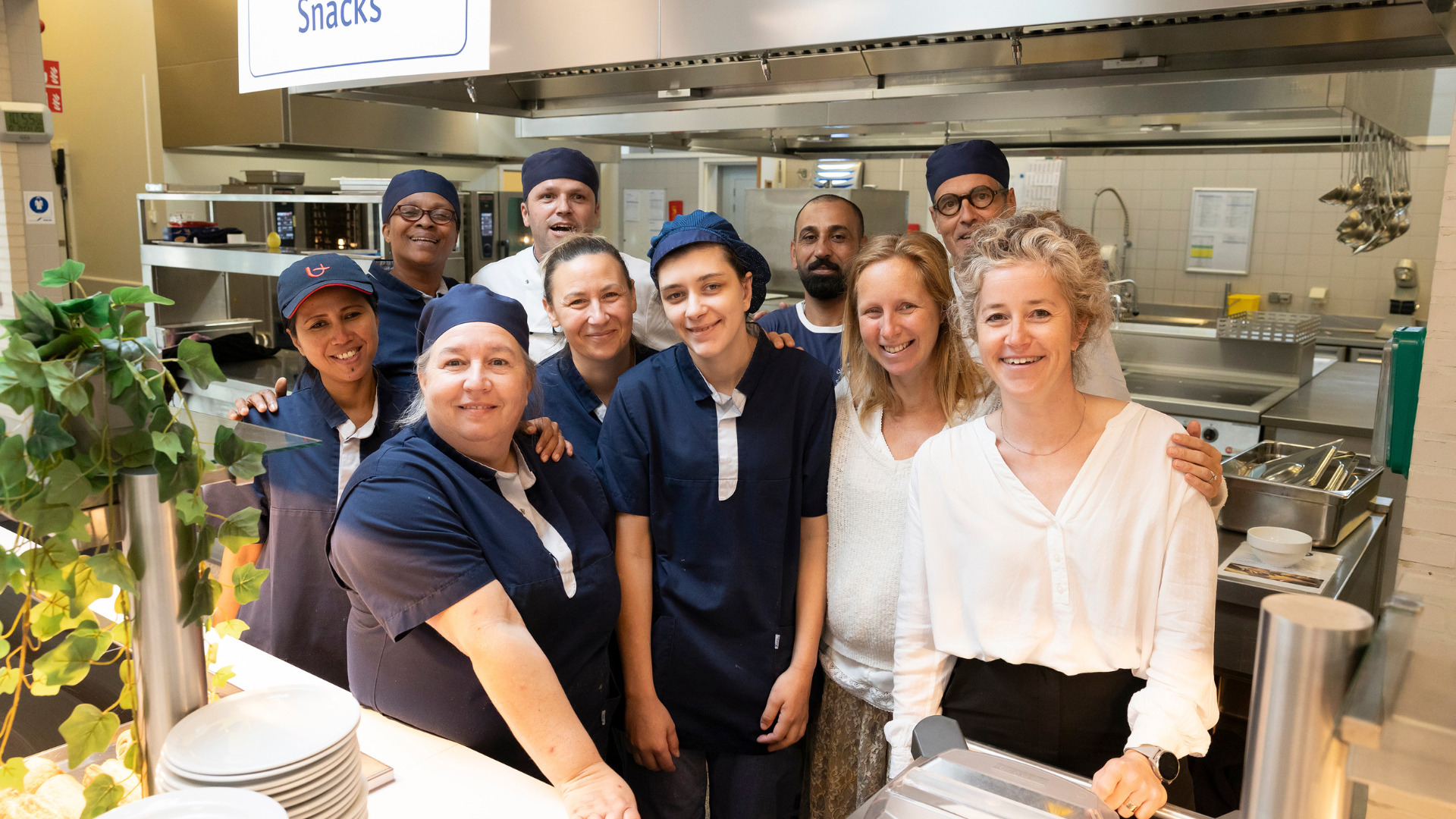Every afternoon, around two thousand hungry staff members and students find their way to komida. ‘Strictly speaking, we are a mass-catering operation, but we make every effort not to be one’, notes the komida coordinator An Op de Beeck. Early one Monday morning, we donned an apron and hair cap and got to peek into the pots for half a day at komida Middelheim.
7:00 a.m. Empty bins
Bart Van Herwegen, the production manager at komida Middelheim, welcomes us with a broad smile. ‘Monday is our most hectic day. That’s because we’re not here on Sunday to do the mise-en-place, and so we start from Square 1’, he explains. Before flying back into the kitchen, he gives us a tour of the cold and hot kitchen, cold and freezer rooms, stock rooms and the sorting and washing-up area. The shutters of the free flow are still down, the bins empty. Soon, they will be filled with hot dishes, snacks and street food. ‘The classic potato with a side of meat and vegetables has gone out of fashion,’ Bart knows. ‘Today, we serve more often casseroles and world cuisine, and thus street food as well. That stuff scores very well, better than the snacks and regular meals combined.’
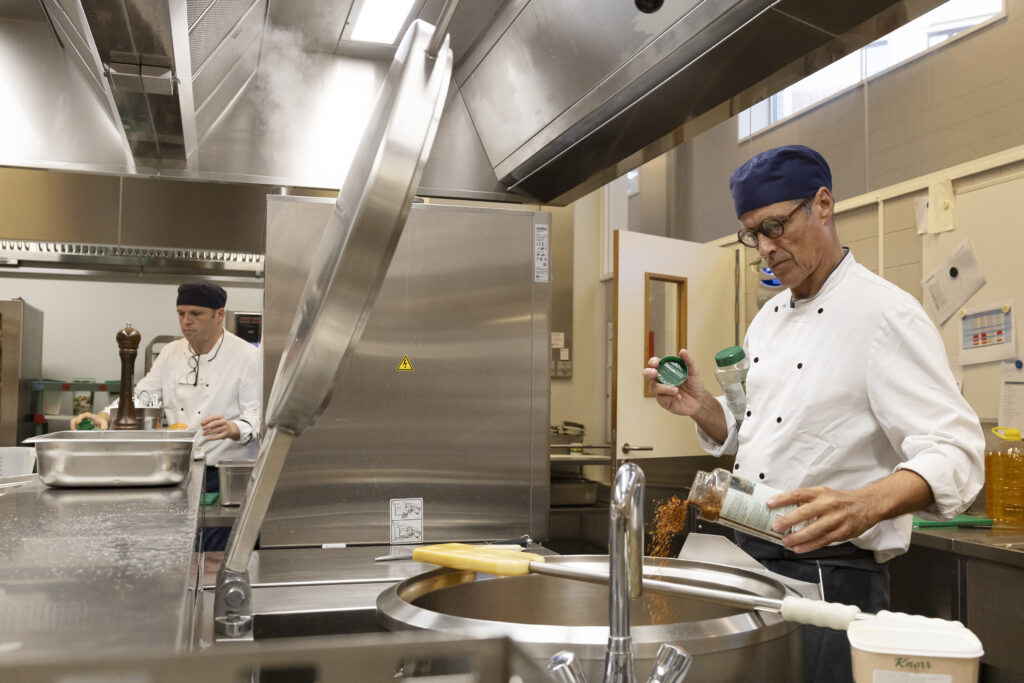
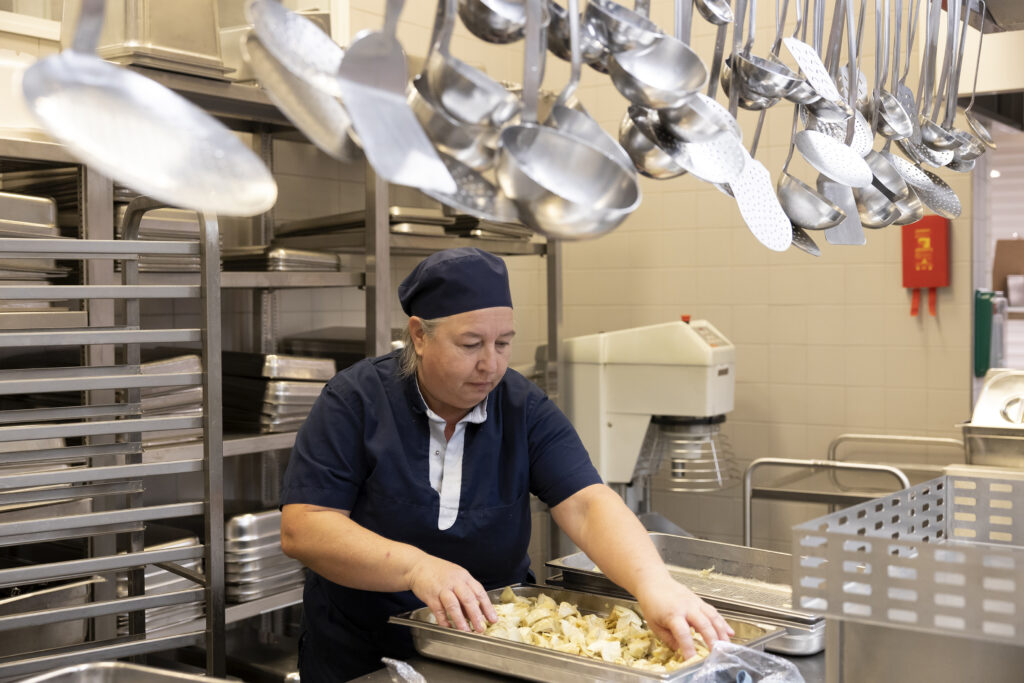
Each komida has its own menu. ‘That’s because the public is different everywhere,’ explains dietician Magali Hiel. ‘Here at Middelheim, we sell a lot of salads, because a lot of staff members come. In komida Drie Eiken, they like healthy and classic dishes, Groenenborger sells a lot of snacks and, at the Stadscampus, things can cost a bit more.’
8:00 a.m. Cutting oranges
In the hot kitchen, Jan Vloebergs is cutting oranges for the fruit salad. He and Bart keep concentrating on their work, but the atmosphere is relaxed. As Jan notes, this is quite different from a ‘normal’ restaurant. ‘We don’t feel that heavy pressure here, and the atmosphere is fun. We get to work with young people, and the working hours are easy to combine with a family. The contact with the students is nice as well.’
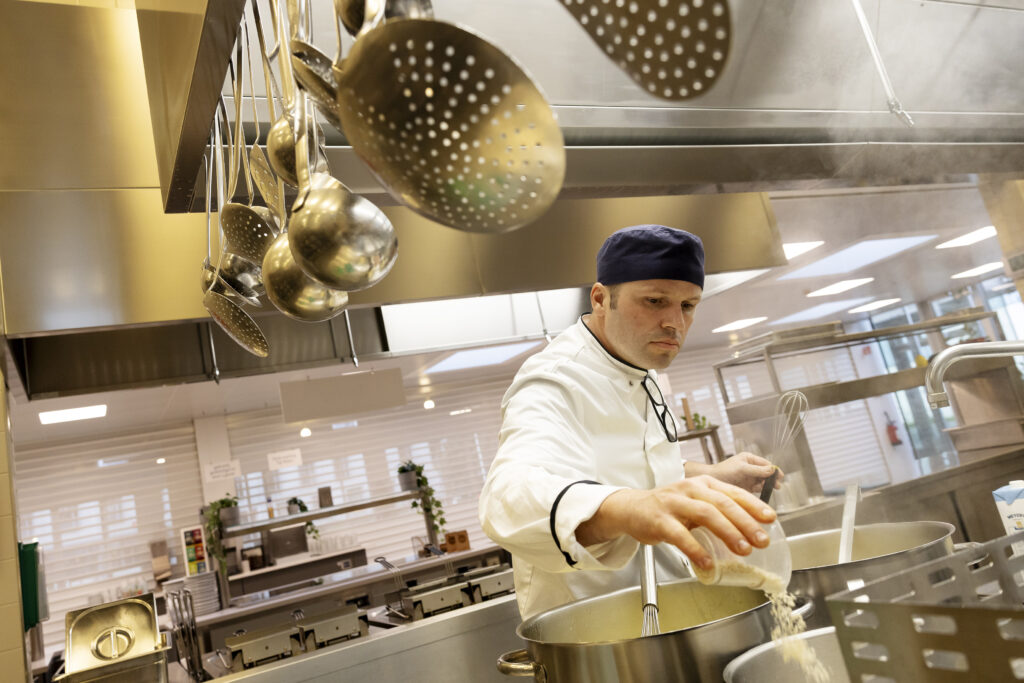
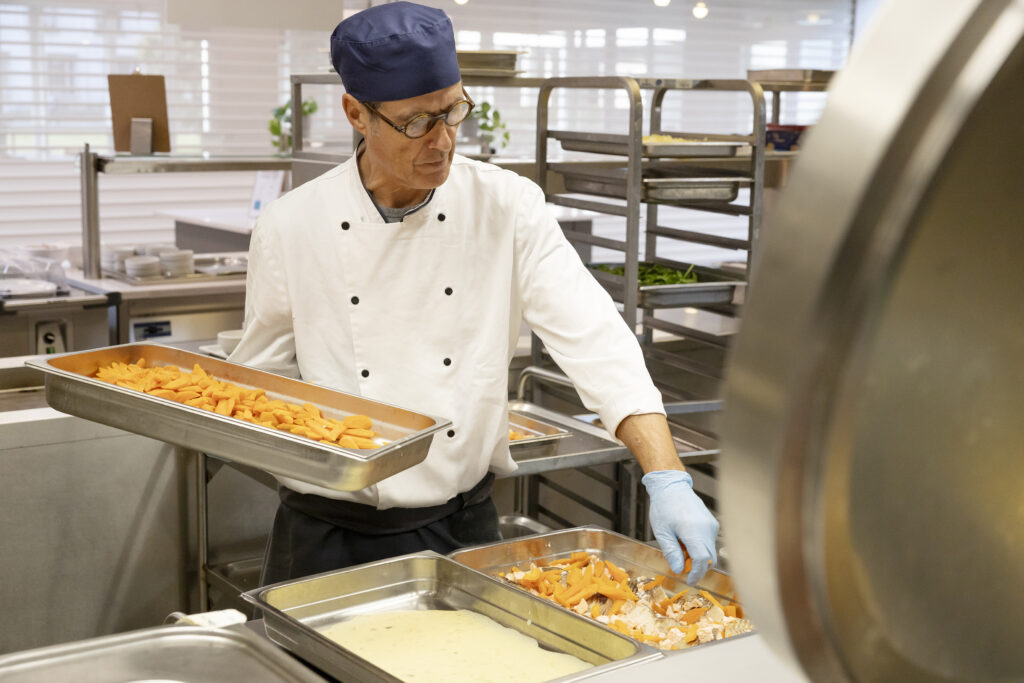
The restaurants are open every week of classes. Each of them now also has a Shop & Go, which offers items including sandwiches and takeaway meals and which remains open even during exam periods. During the holidays, only online service is available. ‘We started doing that during the pandemic’, recounts Magali. ‘At that time, customers could order sandwiches or meals and pick them up later. It worked well, so we kept offering the service, although it’s now available only on holidays. The only time that we’re completely closed in during the Christmas holidays.’
The four komidas together have 30 employees and four administrative staff members. At komida Middelheim, there are eight employees: Seven kitchen staff members and one employee for the coffee machines and dishes One ‘flying’ employee helps wherever needed
9:00 a.m. 180 salads, 80 sandwiches
As Bart cuts the mushrooms, Jan puts the finishing touches on the tabouleh. Bart always puts together a menu for a period of six to eight weeks. He tests it with Magali. ‘Amongst other things, I check the balance between veggie, plant-based and meat dishes, the variation, food prices, the availability of products…I also check whether vegan dishes truly are plant-based and whether the allergen information is correct’ she explains.
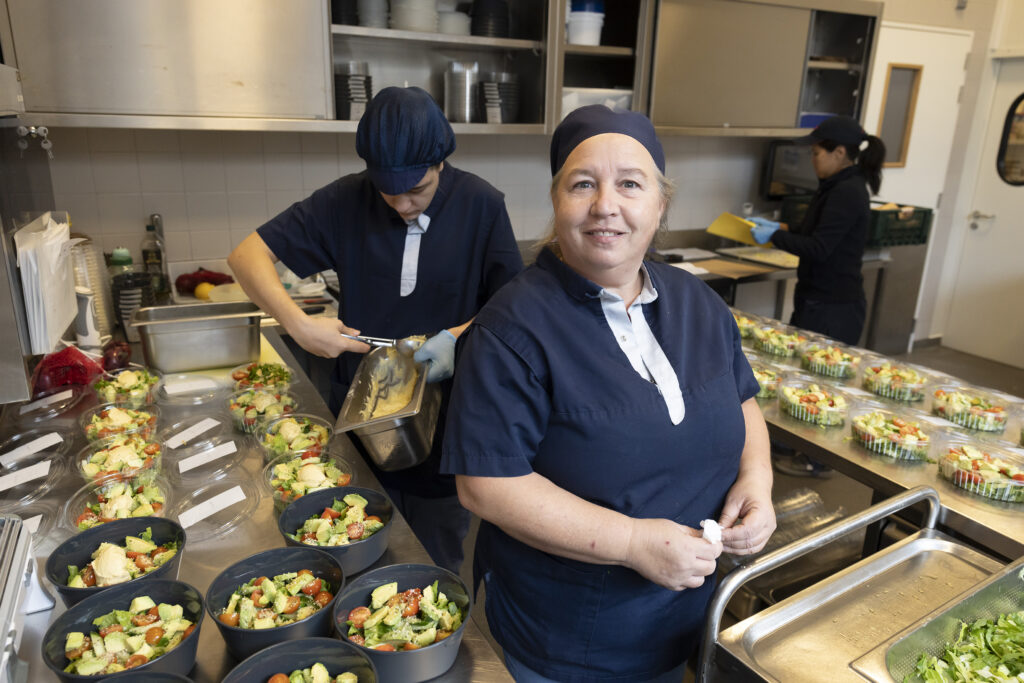
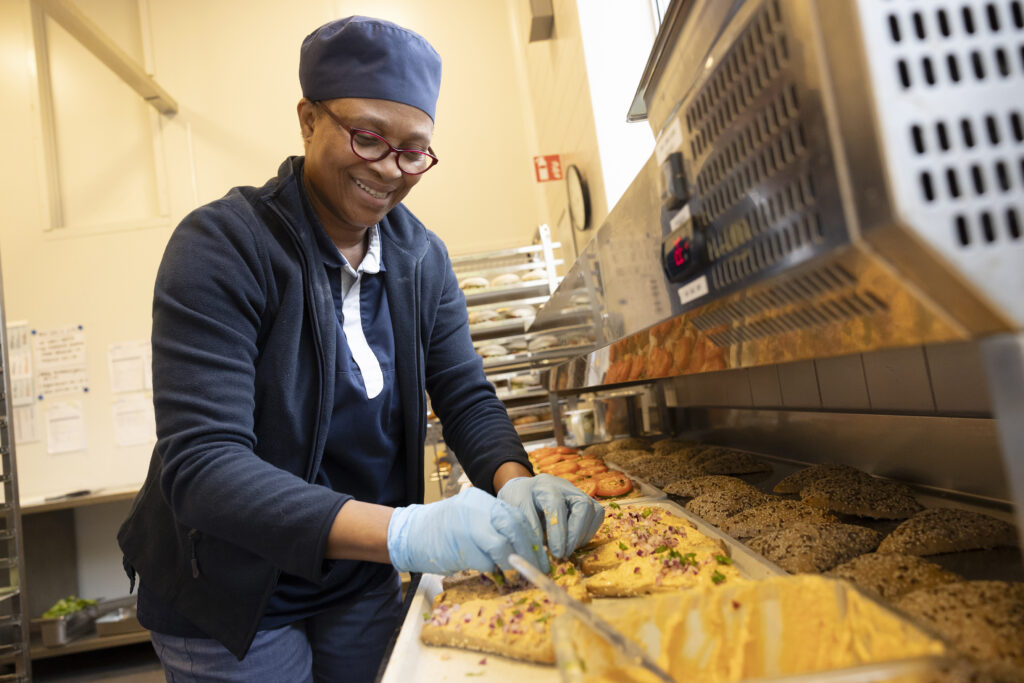
Chefs can choose from a large pool of existing recipes, but they also regularly invent new dishes. As An knows, each chef has a signature dish. ‘For example, Bart is known for his moussaka. We always go for quality and nice-looking dishes. Even if we are mass-catering operation in the strictest sense, we don’t want to be seen that way. Thanks to the enthusiastic team, we can also realise this ambition.’
In the cold kitchen, work is focused, but calm. We have recently started preparing ‘spotlight sandwiches’ and salads for the other komidas. In addition, komida Groenenborger’s soup comes from Middelheim’s pots and pans. Such centralisation reduces waste. ‘Every day, we make around 80 sandwiches and 180 salads here. That’s a lot, but we’re very well coordinated’, says manager Sharon Van Hecke. She and her co-worker Katleen work side by side to make takeaway salads—today, a mixed salad with mango and turmeric hummus. ‘On weekends, I like to look for new combinations. For me, that’s the best thing about this job, being able to create dishes. I see them as little works of art’, beams Sharon.
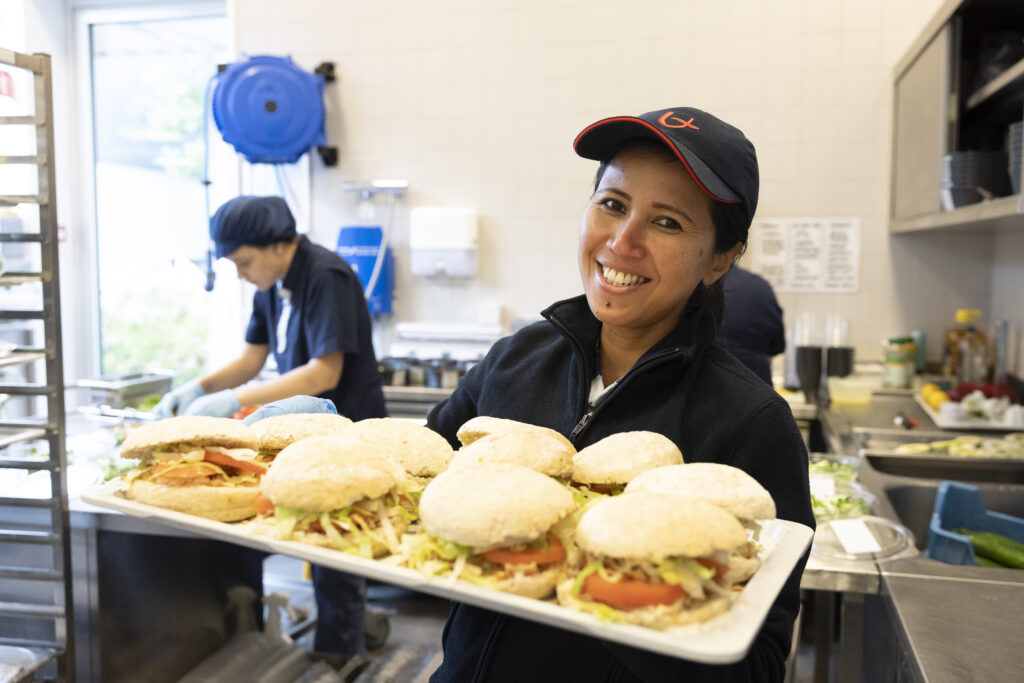
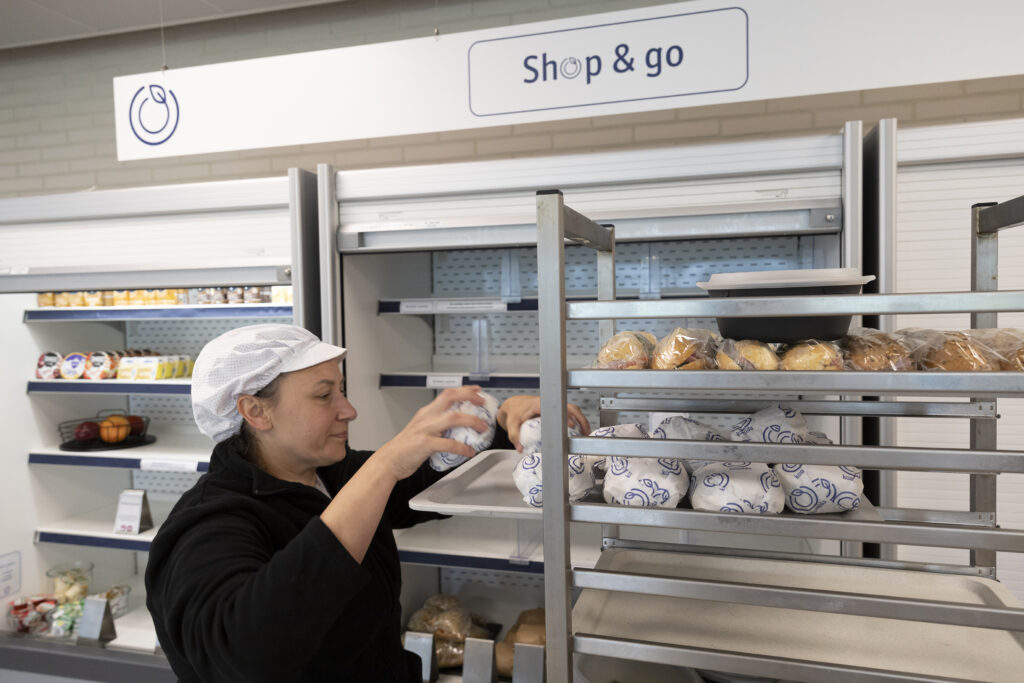
A little further away, Freda Geyevu is filling buns with chicken and sandwiches with vegetarian balls. She has been working here for about eight years. ‘We have a great team’, she says. ‘Everyone does everything here; even our chef does the washing up from time to time. In that sense, we are like a family. If it’s up to me, I’ll work here until I retire.’
10:00 a.m. Everything under control
Anand Magali come to take a look in the cold kitchen. Everything is under control. ‘We go for healthy as much as we can, but we still give our visitors a choice’, explains Magali. ‘The trick is to use small interventions to make the menu healthier without being noticed.’ For example, we are now making our croque-monsieurs with whole-grain bread, and we have reduced the portion sizes of meat from 150 to 130 grams. But we still sell sausage rolls.’
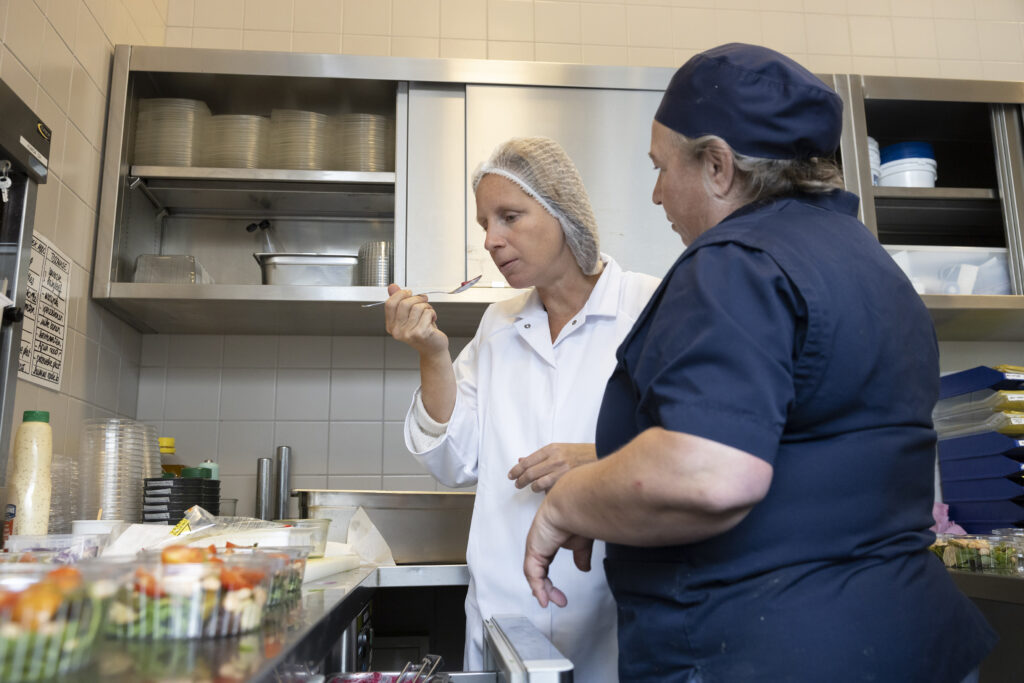
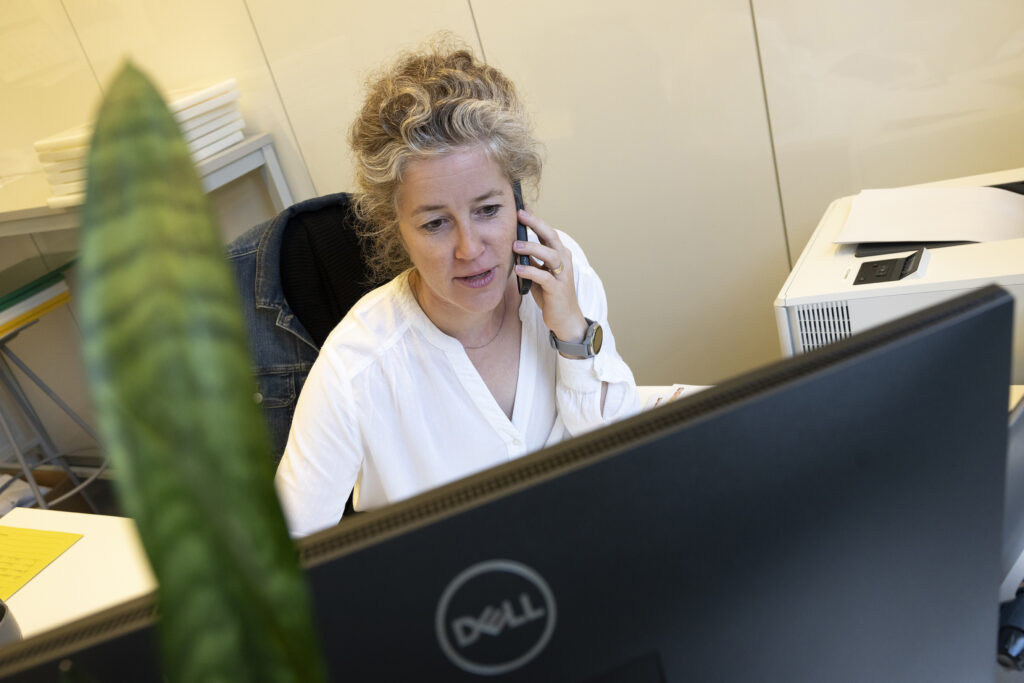
They also attach high importance to sustainability. Komida offers a wide range of vegetarian and plant-based dishes, has removed beef from the menu, no longer sells unflavoured bottled water and has introduced a system of re-usable bowls for takeaway orders. They also opt for seasonal fruit and vegetables. Amongst other things, this means that, in the winter, a Dagobert sandwich won’t have cucumber and tomato, but it will have a mixture of cabbage and carrots. An notes, ‘We’re not holier than the pope, and we continue to aim for a broad public. It doesn’t work to force things. We nevertheless do want to encourage our customers to make good choices in that area too.’
11:00 a.m. Lunch break
While Freda and her co-worker Rina go to distribute dishes to the other campuses, their co-worker Abdallah goes to work in the dish-washing area. The others are taking a short lunch break. ‘Since the pandemic, we’ve unfortunately seen a significant drop in the number of visitors’, observes Bart. ‘After an interruption of almost two years, many people didn’t manage to find their way back last year. The increase in working from home working probably plays a role as well, as well as the increased prices, although they are still low here, relative to suppliers’ prices. We are nevertheless excited about entering the new academic year.’
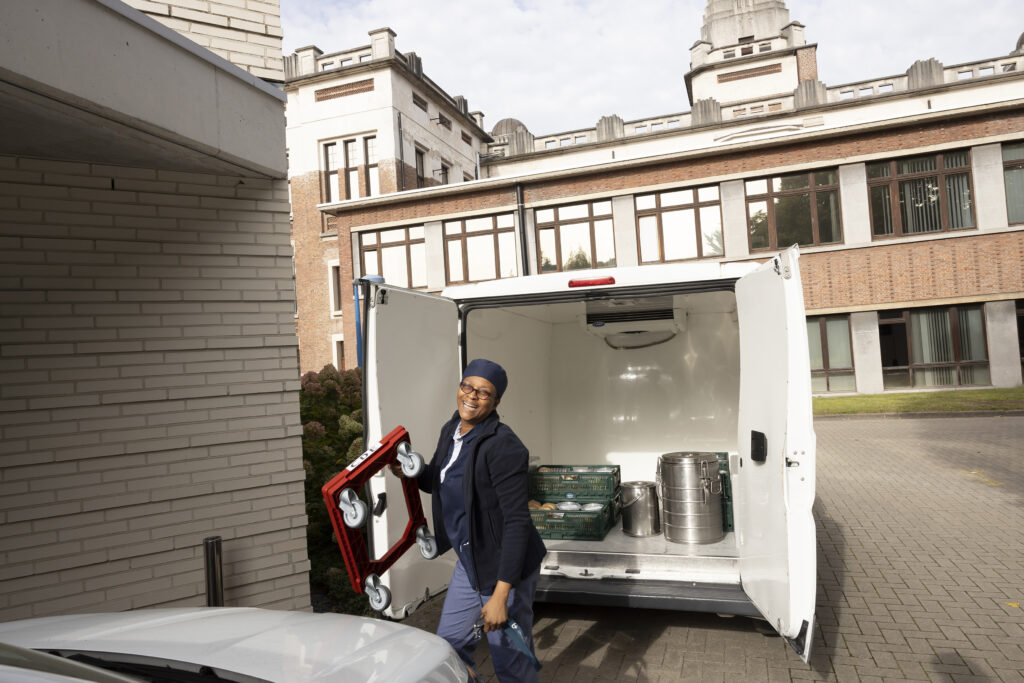
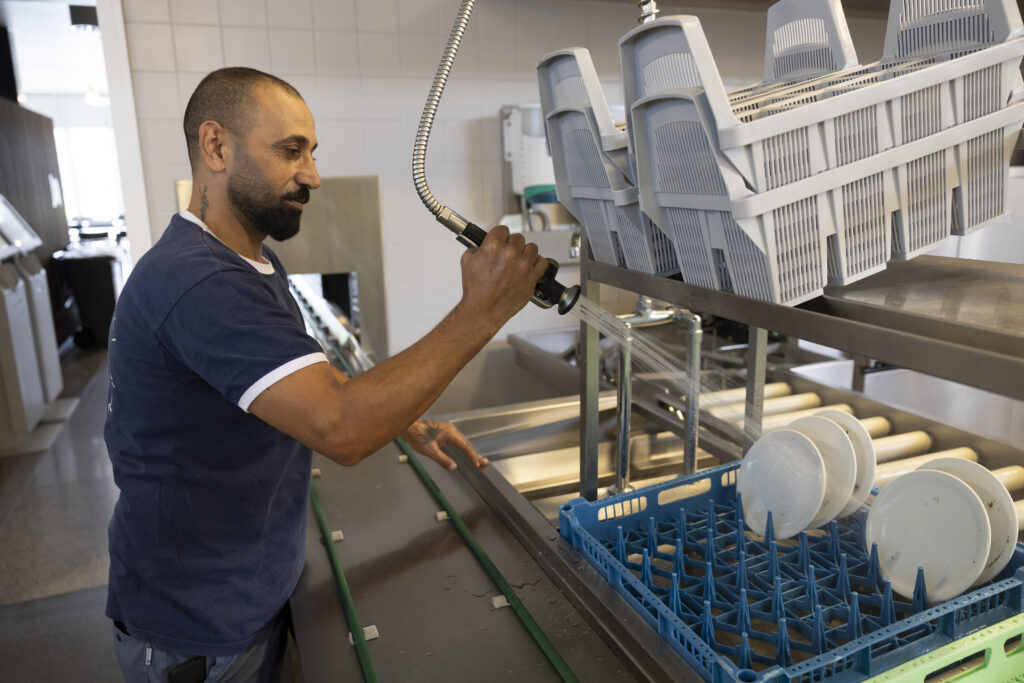
At exactly 11:30 a.m., they spring right back into action. Bart and Jan start making the final round of browning, heating and taking dishes out of the oven. By 11:45 a.m., everything is ready, and the dishes are moved to the serving bins. Jan and Katleen take their places behind the service counters, as Sharon and her co-worker Veronique staff the cash registers. The first customers start to trickle in.
12:00 a.m. Time to eat
The dining hall has since become relatively full. Most customers head directly for the free flow. ‘Customers are also allowed to eat their own lunches here. That way, they can eat together with co-workers who do buy something. In that case, we do like them to combine their lunches with a purchased drink or cup of soup, but it’s not required’, notes An. Those who wish can also reserve a table for a lunch meeting. ‘We do ask them to come before 12:15 p.m. or after 1:15 p.m., to avoid the peak. We then lay out the sandwiches that have been ordered.’ One thing that komida does not do is catering at other locations. For that, there is konventa.
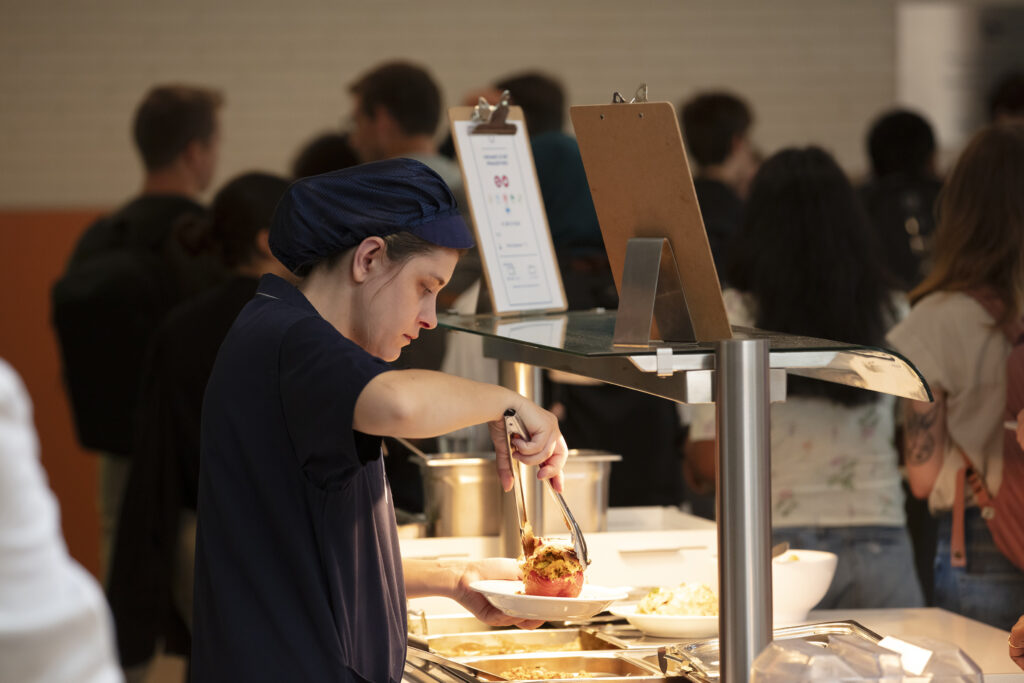
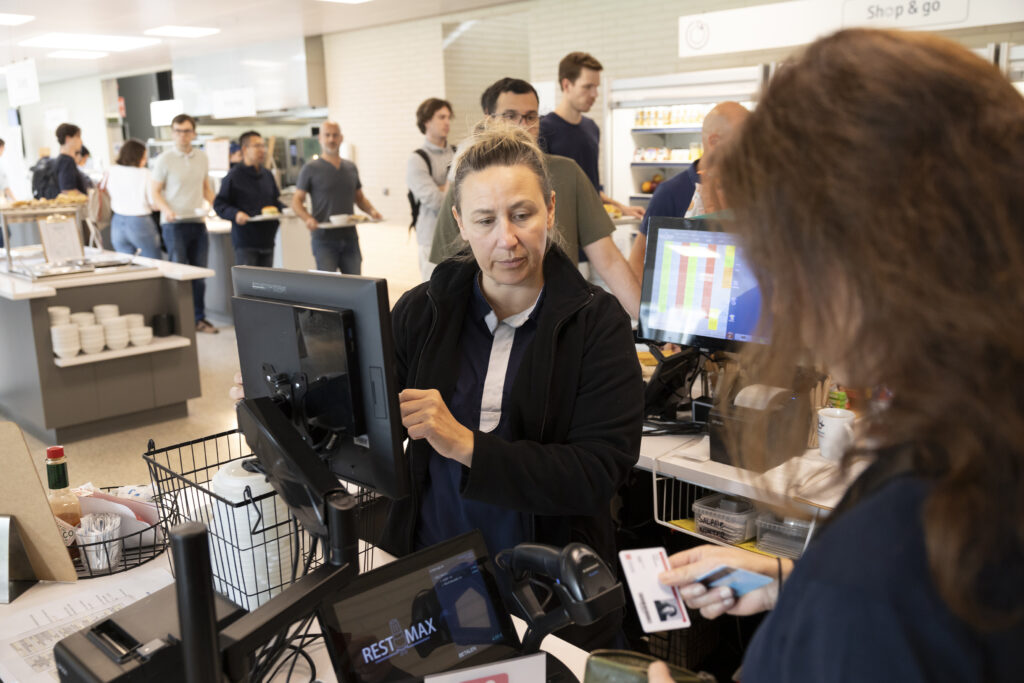
At one of the tables, Tim Apers, a Master student in software engineering, is enjoying his stuffed peppers with tabouleh. ‘I come here a few times a week’, he says. ‘Here, I can eat tasty dishes that I’d never make at home—even though the spaghetti Bolognese is my absolute favourite. I sometimes get that from the Shop & Go too, as a dish to warm up for my girlfriend. During the pandemic, I regularly ordered online. Can I still do that on holidays? That’s nice to know.’
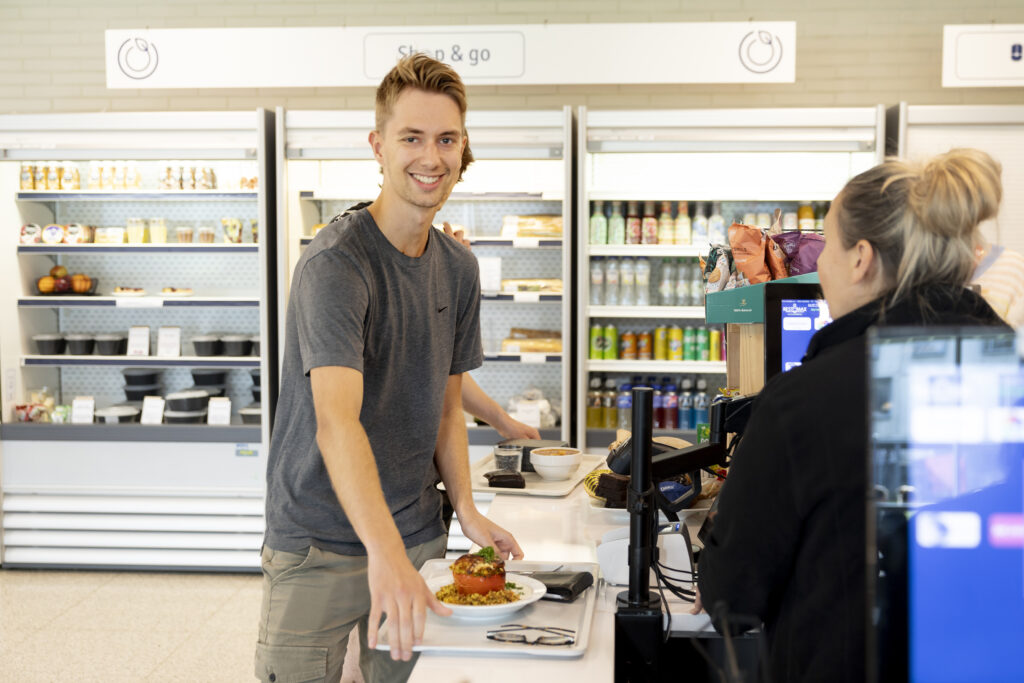
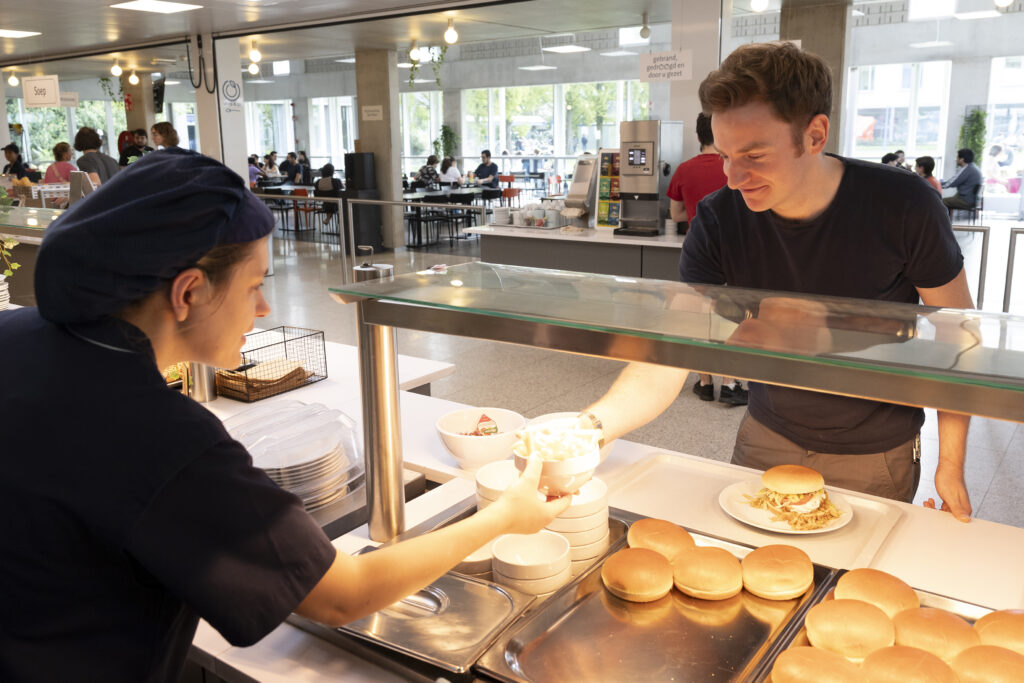
Hannes den Ouden is also a regular customer. He works in IT and can be found here around four days a week. ‘I make a conscious effort to come to the office every day, and it helps that there’s a good company restaurant. The food here is tasty—but please have the vegetarian pizza more often! In the end, however, it’s the warm welcome that makes all the difference. I’ve gotten to know Jan and Bart personally.’ Hannes is conscientious about what he eats. ‘So that’s my main suggestion: to indicate the amount of proteins, sugars and fats in each meal. I like the fact that they work sustainably. It’s too bad that the beef had to go, but I understand.’
1:00 p.m. No waste
Once the last visitor leaves, the kitchen team will still have a lot of work to do: cleaning up, washing up, placing orders… Unsold meals are offered for a pittance through ‘Too Good To Go’. ‘People come by to get then every day, often the same faces from the neighbourhood. For them, it’s a good solution. For us, it means less waste. It also creates connections in the neighbourhood’, thinks Jan.
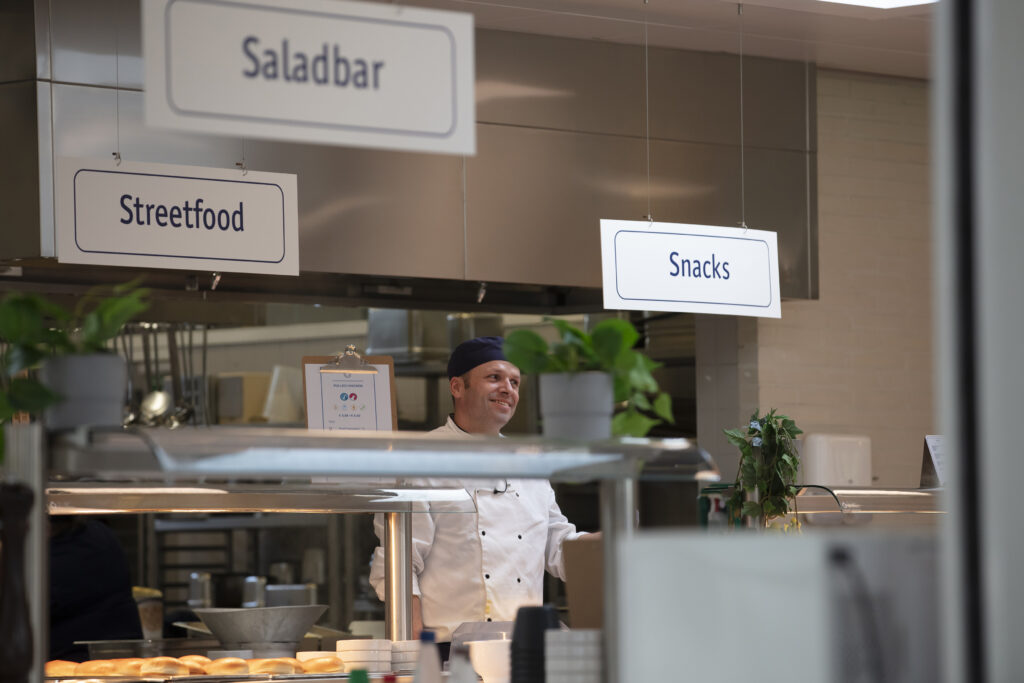
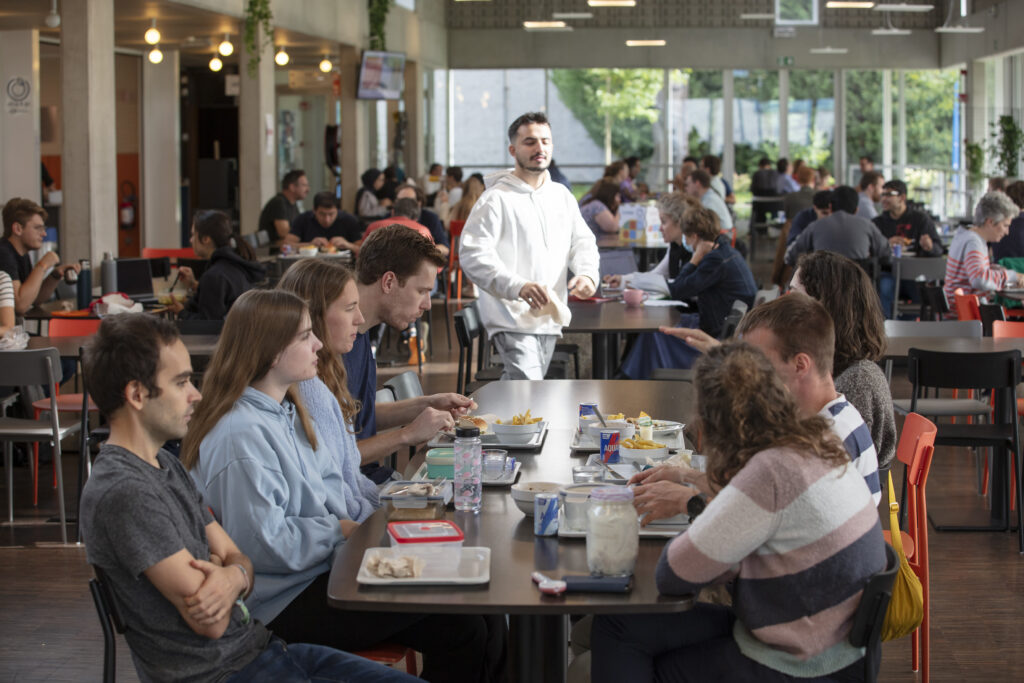
In the meantime, they’ve already started the mise-en-place for tomorrow. ‘Things like washing lettuce and baking vegetables can be done perfectly right now. That way, we can be more relaxed tomorrow’, explains Sharon. Nevertheless, she doesn’t like to use the word ‘stress’. ‘I prefer to call it adrenaline. And once everything’s done, I think to myself, “That’s another job well done”!’


